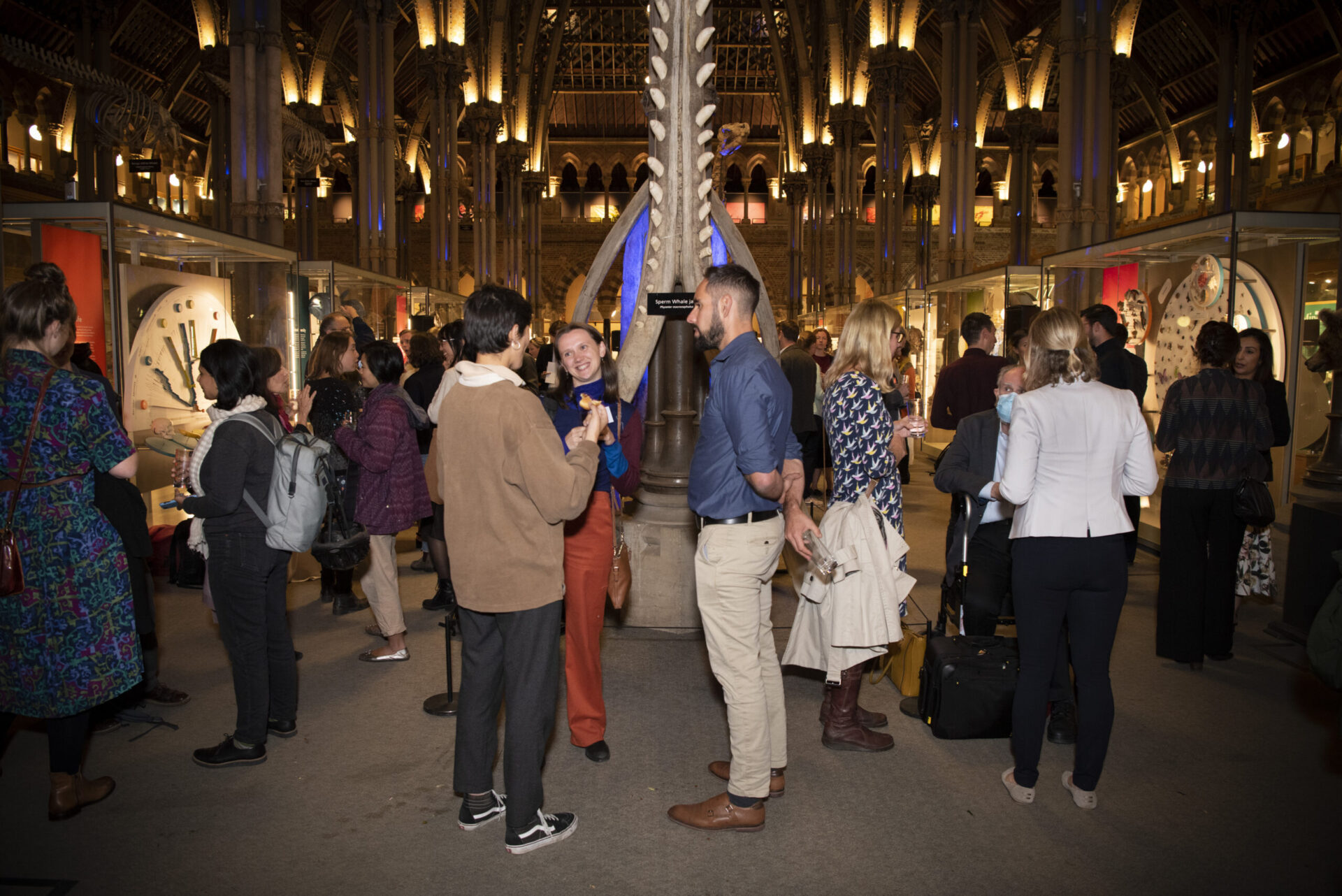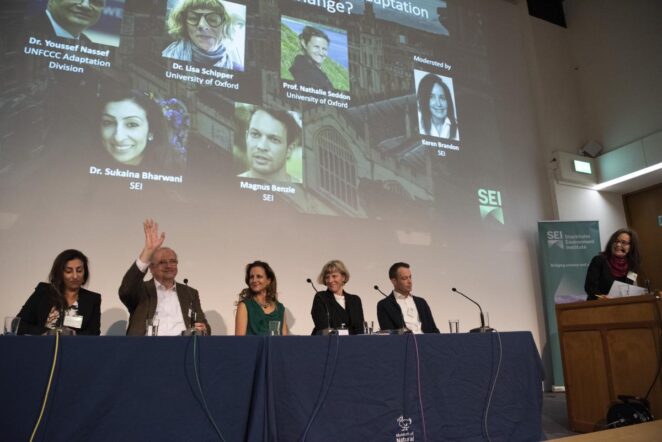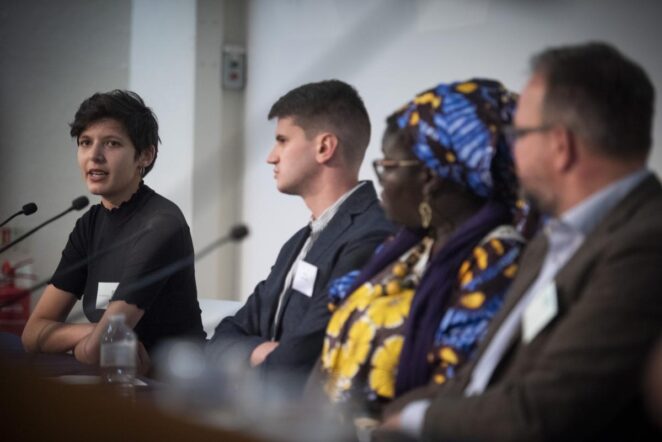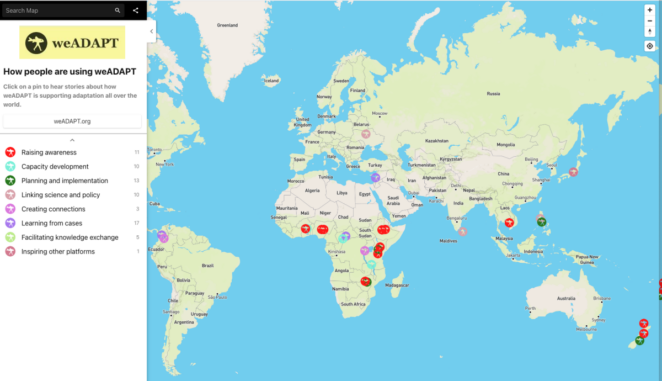SEI Oxford’s 20th and weADAPT’s 15th Anniversary: The Future of Climate Change Adaptation

Summary
SEI marked the 20th anniversary of the Oxford Centre and the 15th anniversary of weADAPT with an event that addressed goals for adaptation, barriers to adaptation, and ideas to achieve greater progress. This article provides an overview of the event, links to recordings, and takeaways from the panel discussions.
About the event
On September 29th, the staff of SEI Oxford gathered at the University of Oxford Natural History Museum along with colleagues, friends, partners, and other interested parties to consider the future of adaptation and celebrate SEI Oxford’s 20th and weADAPT’s 15th anniversary. The event began with a speech from Ruth Butterfield, the director of SEI Oxford. Her speech was followed by a panel consisting of adaptation experts discussing the goals, challenges, and future of adaptation moderated by Karen Brandon. A second panel then had a lively discussion about adaptation in the context of generational differences, featuring two senior adaptation researchers along with two youth adaptation researchers and activists. The speaking portion of the event was closed with words by Åsa Persson, the Research Director and Deputy Director of SEI. Participants then gathered on the main floor to enjoy drinks, canapés, cake, and networking.
Adaptation Panel
In the opening session, five panellists presented diverse ideas about the main goals for adaptation, the key barriers to adaptation and ways to achieve progress on the agenda. The panelists in this section were:
- Youssef Nassef – Director of the UNFCCC Adaptation Division
- Lisa Schipper – Affiliated Researcher, SEI, (Incoming) Professor of Development Geography, University of Bonn
- Nathalie Seddon – Professor of Biodiversity and Senior Associate, International Institute for Environment and Development, University of Oxford; Senior Fellow, the Oxford Martin School
- Magnus Benzie – Research Fellow, SEI Stockholm
- Sukaina Bharwani – Senior Research Fellow & weADAPT Coordinator, SEI Oxford.

The panelists answered the following questions with responses that are summarised below.
What are the main goals for adaptation?
- Sustaining development in a climate-constrained world
- Rapid scaling of place-based holistic approaches to adaptation
- Systemic resilience, where nodes and the global system are resilient
What are the barriers to adaptation?
- Short-termism
- Cognitive barriers – no sense of urgency
- Limited access and not enough information on what works and does not work
- Siloed policy structure
- Insufficient appropriate finance for vulnerable people
- Lack of holistic thinking on adaptation
- Inability to address cascading and compounding risks
- Insufficient and unclear risk ownership around adaptation
- Power is still held by Global North institutions which affects how programs and projects are implemented
How do we speed up and scale up adaptation?
- We need a balance between speeding up adaptation and ensuring an inclusive adaptation so as not to create maladaption
- We need a multilateral approach based on principles of solidarity and interdependence
- We need to address the funding gap for adaptation
- We need to co-produce knowledge by building the capacities of more people
- We need to shift the power from global north to global south institutions
- We need a change of narrative towards indigenous values
Intergenerational Panel
A second panel held a lively, intergenerational discussion. The voices of experience were represented by two experts who have been working on adaptation-related causes globally throughout their careers; the voices of the up-and-coming generation were represented by two young people who have been active in research and in championing both social justice and greater inclusion of youth in climate change-related decision-making globally.
Participants included:
- Arame Tall – Senior Adaptation and Resilience Specialist, Climate Change Group, World Bank
- Richard J. T. Klein – SEI Senior Research Fellow and Professor of Geography, Climate Policy and Development at Linköping University
- George Carew-Jones – UN COP Working Group Member and Press Officer, UK Youth Climate Coalition
- Inès Bakhtaoui– Research Associate, SEI Oxford.

The panelists discussed the differences in their perceptions of the goals and challenges for adaptation based on their generational differences. They also discussed youth activism, and the different benefits both youth and more senior researchers can bring to the table. Another point brought up by the panelists was the multitude of global crises the world is currently facing, including challenges with economic systems. The panel spoke at length about the interactions between adaptation and other sectors.
Virtual Panel
Three additional panelists were unable to attend in person, and submitted their responses to questions about the main goals for climate adaptation, the key barriers to adaptation, and ways to achieve progress in adapting to climate change. The responses were recorded and edited into this video which was played during the networking portion of the event. The featured panelists in this video are:
- Kathryn Brown – Director of Climate Action, Wildlife Trusts; former Head of Adaptation, UK Climate Change Committee
- Gilbert Siame – Associate Professor of International Urban Development Planning, Norwegian University of Science and Technology
- Albert Salamanca – SEI Senior Research Fellow, SEI Asia
weADAPT Impact Story Map
The anniversary also showcased our weADAPT Impact Story map. The map reflects findings from in-depthinterviews with users (originally surveyed in 2021)showing that weADAPT is used in vastly different ways by diverse actors and in multiple locations. We have been inspired by how far and wide the platform’s content has motivated others and their climate change adaptationwork. Some examplesinclude supporting youth educationand youth-led climate action, providingtraining for farmers, displaced communities, and women and girlsas well asconnecting organizationsto formnewregional and internationalcollaborations across sub-Saharan Africa.
weADAPTcontent has also provided rich, local context for research from Colombia to India and has, for example,suppliedscientific knowledge for the Sri Lankan Third National Communication on Climate Change.Resources and events shared by weADAPTusers haveprovidedtranslationofclimate-related concepts needed by policymakers at local,municipal and national levels from places as diverse as Ethiopiaand Ukraine toNew Zealand. It’s also inspiring to hear that this newsletter is regularly printed to share in local librariesfor communities who have limited access to the internet.
To explore some of these examples, check out theImpact Story map.Do you have a story about how you’ve used weADAPT? Share it with us at [email protected] and we will add it to the map.

(0) Comments
There is no content